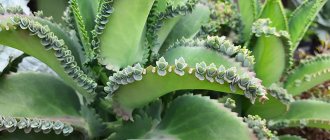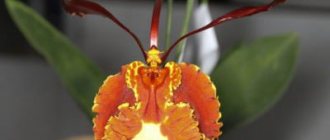In one of the previous articles about cacti, we already mentioned Epiphyllum, but only in passing, now it’s time to talk about it in more detail.
To begin with, I would like to remind you that Epiphyllum is a forest cactus with wide stems, vaguely similar to Decembrist (zygocactus) and also belongs to the genus of epiphytic plants. Mexico is considered its homeland, but today this species is increasingly found in the homes of cactus growers and ordinary people. This type of cacti is notable for the fact that it has 20 varieties, each of which is interesting in its own way.
In this article, we will try to consider the most interesting of them, and tell you how to properly care for Epiphyllum at home and what needs to be done to make it bloom. Let's begin!
What does epiphyllum look like, what family does it belong to?
Epiphyllum is a flower that belongs to the cactus family, there are 20 species. The name is of Greek origin, translated “to the leaf.” This combination of words occurred due to the similarity of the stem in shape with the leaf. The culture is found in the wild in the tropics of South America and the forests of Mexico.
Epiphyllum Monstrosa is sometimes called pink
Common varieties
There are hybrid and natural plant varieties. They differ in the shape of the leaves and the size of the flowers. Many can be grown on the windowsills of apartment buildings if you care for them properly.
- Epiphyllum Marniera is a forest cactus, represented by long, flat shoots that are strongly dissected into leaf-shaped lobes. The diameter of the white flower is on average 25 cm. In the center of the bud there are fluffy golden stamens with a pleasant smell. The plant blooms at night.
- Epiphyllum Monstrosa or Guatemala is notable for its long, twisting stems. For the various shades of light red flowers, this variety is also nicknamed pink epiphyllum.
- Epiphyllum Anguliger grows only in Mexico. The angular epiphyllum received its nickname due to the ornate shape of the stems. The stems can grow up to 1 meter in height, the flowers are large - 15 cm in diameter, and have a pleasant smell. The lower leaves of Epiphyllum anguliger become woody over time.
- Epiphyllum Oxypetalum in nature can grow up to 3 meters long. The plant has flat, narrow, hanging stems that reach a length of 10 cm. The snow-white flowers of Epiphyllum oxypetalum open at night and fill the room with a tart aroma.
- Epiphyllum Ackermann is often found in apartments. The plant is represented by 3-sided hanging stems, along the edges of which there are rounded notches. The leaf blades are 5 cm wide and grow up to 60 cm in length. Up to 15 buds can bloom simultaneously at the tops of the peduncles. The most common red flowers are epiphyllum. Thanks to their ampelous shape, the bushes can be grown in flowerpots, hanging them on the wall.
- Epiphyllum acupetallus was named so for the pointed shape of the stems, which have the shape of narrow, long leaves. The second name is Epiphyllum White, for the exceptionally white hue of the flowers, which in their shape resemble lotuses.
Attention! Many varieties of epiphyllum are suitable for home cultivation. The main thing is to know and follow the rules of flower care.
All varieties of crops require moderate watering and good lighting.
Epiphyllum anguliger has large flowers
Types of epiphyllum with photos and names
Both natural types of epiphyllum and hybrids are grown indoors.
Epiphyllum oxypetalum, or sour petal
The species is most popular in culture. Its large bush can reach a height of about 300 centimeters. The twig-like stems become woody in the lower part over time. They are flat and have a wavy edge; the shoots reach up to 10 centimeters in width. The length of the white flowers is about 20 centimeters, and they reach up to 18 centimeters in diameter. The species has hybrids that differ from each other in the color and size of the flowers.
Epiphyllum anguliger, or angular
The bush is distinguished by its strong branching. Dark green rounded (can be triangular) shoots become woody in the lower part, while in the upper part they are triangular or flat. Their width is 40–80 mm, and their length is about 100 cm. The rich red fragrant large flowers reach about 80–100 mm in diameter.
Hooker's Epiphyllum (Epiphyllum hookeri), or acute petal
It is found naturally in Venezuela, Cuba and Mexico. There the bushes can grow really huge. Large white flowers with a subtle scent are formed on long shoots. The stems are very heavy and therefore bend downwards in an arc.
Serrated epiphyllum (Epiphyllum crenatum)
This is a semi-epiphytic cactus. Its greenish-blue shoots reach about 0.7 m in length and up to 10 centimeters in width. There are many deep cutouts on the edge. The fragrant flowers reach about 15 centimeters in diameter. The species has many hybrids that differ in flower color.
Epiphyllum phyllanthus
This species grows in South America. The length of the stems is about 100 cm, while the length of its secondary leaf shoots is 25–50 cm. The diameter of the pink flowers is 15–18 cm.
Guatemalan Epiphyllum (Epiphyllum guatemalense)
Its shoots look as if oak leaves, each 50 mm in size, were connected together. There is a variety of monstrosa: its shoots can change the shape of the shoots and wriggle in a chaotic manner. The flowers of this species are colored in various shades of pink.
Epiphyllum thomasianum
In wild conditions, the shoots of the plant are about 400 cm long, and in indoor conditions - about 70 cm. The center of the large white flowers is yellow, they reach up to 25 centimeters in diameter.
Epiphyllum ackermanii
The shoots of the plant are drooping. At a height of 40–70 mm from the base, they have multi-toothed flat processes. Fiery red flowers adorn the slender stems.
Epiphyllum laui
This lithophytic and epiphytic species is characterized by rapid growth. In diameter, the main stems reach about 20 mm, and the lateral ones - up to 70 mm. The stems have hair-like spines of a brownish-yellow hue, the length of which is about 0.4 cm. The opening of creamy-white flowers is observed in the evening. The lifespan of each flower is approximately 2 days.
Popular hybrids:
- Unnamed hybrid created by F. Nunn. The center of the flower is white, then it smoothly turns into a pinkish color, and the edge of the petals has a rich purple hue.
- King Midas . The length of the dark green shoots is about 150 cm. Large orange-yellow, almost golden, flowers reach up to 16.5 centimeters in diameter.
- Just Prue . The center of the flowers is pinkish, and the edges of the petals are dark pink. In diameter they reach from 12 to 16 centimeters.
- Johnson . The color of the flowers is dark scarlet.
- Wendy May . The flowers are a deep crimson color and have an unusual shape: the petals growing in the center are short and with rounded tops, and the edges are long and sharp.
- Jennifer Ann . The large flowers have a lemon tint.
- Martina . The cascading shoots are divided into small oval-shaped segments. The fragrant elongated flowers are red in color, with a yellowish center.
EPIPHYLLUM CARE. My Experience for Beginners! /EPIPHYLLUM BLOWING!!!!
Features of caring for a cactus at home
Echinopsis cactus - home care
The flower cannot be moved from its permanent place on a window or wall. The bush may begin to shed buds and flowers.
Temperature
The optimal summer temperature for the flower is 20-25 °C. In autumn, the plant is moved to a cooler room. During the rest period, the heat level in the room should not exceed 15 °C.
Lighting
From the bright sun, the stems of the plant begin to wrinkle and turn yellow. The pot can be placed on the east side; on the south window sill it is necessary to shade the direct rays of the sun. In summer, it is recommended to move the flowerpot outside so that the plant receives more oxygen. But in an open space, the risk of pest infestation increases.
Watering
Watering the bush should be moderate, otherwise it will rot. Before moistening the flower, make sure that the soil in the pot is completely dry. The plant is watered with melted or boiled water at room temperature. In winter, watering is halved; if the room is very cold, watering is stopped altogether.
Long drought leads to drying of shoots and lethargy of leaves. To stimulate the growth of buds, the amount of watering is increased.
Humidity
The plant loves moist air; the stems need to be irrigated daily with a spray bottle. The need for humidity increases if the room where the epiphyllum grows is hot. But a long stay in wet soil can lead to fungal diseases.
The result of excessive watering is the appearance of fungus
Priming
The tropical plant prefers soil rich in mineral elements. You can make the substrate yourself by mixing sand and humus 4 to 1. The soil should be of high acidity.
Feeding
During the flowering period, the plant is fed with cactus fertilizer once every 2 weeks. Fertilizing with a solution of manure in a ratio of 1:4 has a beneficial effect on the ovary of buds.
Care
There are usually no special difficulties with growing Epiphyllum, and the process itself is practically no different from how other cacti are grown. However, in this section, we will tell you how to grow this type of cacti at home and consider such important points as:
Location and lighting
Since Epiphyllum is a forest cactus, it does not like too bright sun, therefore, the best option would be an eastern window or any other, but slightly darkened one. The plant loves light, but remember to avoid direct sunlight. During the dormant period, additional artificial lighting is not required.
Temperature
The most optimal temperature for a cactus is 23-25 degrees Celsius, and in winter and the rest period - from 10 to 15. Air humidity should be slightly above average, but if you do not have the opportunity to create such conditions, then it’s okay - the plant quickly adapts to any humidity, even the lowest.
Watering
From November to March, watering should be minimal - 1-2 times a month, with warm water. In spring and summer, the cactus should be watered more often, but the main thing is not to overdo it. Check the soil moisture yourself. Most importantly, do not let the soil dry out. If the soil is loose, dry, but slightly moist, this means it’s time to water. Use lukewarm water, but never from the tap.
Feeding with fertilizers
Fertilizing is best done during the period of active growth or flowering. Usually, this moment falls in spring and the first month of summer. The plant should be fed once a week or two, it all depends on the fertilizer. Usually the packaging indicates the timing and dosage. It is best to use mineral fertilizers themselves, with a high content of calcium, potassium and phosphorus, but without nitrogen!
A high nitrogen content will simply destroy the cactus, remember this.
The soil
Young plants need good soil. As a rule, up to three to five years of age, ready-made soil is used, which is sold in flower shops. After this age, the land is made independently. To prepare the soil at home, you will need:
- Peat
- Ordinary land
- Sand
- Charcoal or earth
- Small crushed stone or crushed brick
- A little humus (compost)
It is necessary to mix all the ingredients in the following proportion 1:1:1:1:1:2 (you can use more compost). Be sure to mix everything well. This way, you will have ready-made soil that can be used at any time, for example, for replanting.
Older plants need almost peat soil, with a small content of compost and sand.
Transfer
Once every 2-3 years, Epiphyllum, and any other type of cactus, should be replanted. The plant needs replanting for further growth, and the soil still wears out, no matter how you fertilize it. For transplantation you will need:
- soil (ready or prepared yourself);
- drainage (expanded clay, crushed stone, brick chips);
- pot.
In a new pot, place a layer of drainage on the bottom so that it is 3-4 cm thick. Then, pour a little soil on top of the drainage. Now, you need to remove the cactus from the old pot. This is done simply - turn the pot over and knock on its bottom. Just do all this carefully, since Epiphyllum has spreading stems and can be easily damaged.
When the cactus is removed, shake off the root system a little from the old soil and place it in a new pot. All that remains is to fill the container with soil and water. If the transplant is carried out during the active growth phase, then fertilizing with fertilizer should also be done.
Trimming
Since Epiphyllum is quite spreading, the plant should be pruned periodically, every 3 years. This is easy to do. Use a sharp knife to safely remove damaged and improperly growing stems. You should also cut off those stems that already had flowers 2 years ago. It will not be possible to see new flowers on them, and they will interfere with the plant. You should also remove those shoots that have never bloomed.
After pruning, be sure to sprinkle the cut areas with charcoal or ash.
Rest period
The resting period of the cactus begins from the end of October until March. At this time, you should not disturb the cactus, do not touch it again or rearrange it. Temperature 10-15 degrees. Watering is carried out rarely and in very small dosages - 1-2 times a month, several tablespoons of water. Water at room temperature. It is also worth mentioning that at this time, you can fertilize with certain types of fertilizers that are designed specifically for cacti.
Also read: Mammillaria is a favorite among cacti!
Bloom
Depending on the species, Epiphyllum can bloom up to twice a year - in spring and early autumn. The most important thing is, as soon as you see the formation of buds, do not touch or turn the pot under any circumstances, otherwise you can ruin everything. At this time, cacti are very sensitive to any actions. If your pet does not bloom, then there may be several reasons:
- First of all, age. Usually, the first flowering of cacti is possible in the second or third year.
- If everything is in order with age, it means that mistakes were made in caring for the plant.
- Watering is disrupted, there is a lack of light, incorrect conditions are created during the dormant period, etc. All of this affects whether your cactus will bloom or not. So, keep that in mind.
- Well, as a consolation, we can add that there has never been a cactus that has never bloomed!
Reproduction
The propagation of Epiphyllum is no different from other types of cacti. You can do this in several ways:
- Seeds;
- Cuttings;
- By division.
Now a little more about each of them:
Seeds
In one of the previous articles, we wrote about how to grow cacti from seeds, so in order not to repeat ourselves, we recommend that you familiarize yourself with it. In short, the seeds are taken, soaked in a light solution of potassium permanganate, and then sown in a greenhouse with special soil. Then, we should expect the emergence of seedlings, and after 3 months, the seedlings are planted in separate pots.
Cuttings
To propagate by cuttings, you will need:
- Sharp knife;
- Soil for cacti;
- Pot;
- Sand.
First of all, prepare a new pot where the cutting will be planted. It is better to choose a pot that is not too high and wide. Next, it needs to be filled with soil, about 5-6 centimeters.
The next stage is preparing the cuttings. To get a cutting, select a healthy and young stem from a cactus, and then, using a sharp knife, cut off a part 10-15 cm long. After this, the cutting must be removed to a windowsill or any other place for 2-3 days, so that it is slightly dried out. After the cutting is ready for planting, make a small hole 2-3 cm deep in a ready-made pot and plant the seedling in it. When everything is done, take the sand and pour it into the pot in even layers, 1.5-2 cm thick.
Remember, the first watering of the cutting can only be done on the third day after planting.
Division
This method can be used when transplanting a cactus to a new location. When you remove the plant from the pot, shake the root system off the soil and see how much of the cactus can be separated. This is easy to do - the most important thing is that the part that you will separate has good and healthy stems, as well as intact roots.
As soon as you find such a part, separate it from the main plant using a knife, and be sure to sprinkle the cut area with ash or crushed charcoal. Next, plant the resulting plant in a pot like an ordinary cactus and begin caring for it. Nothing complicated!
Also read: Astrophytum - Mexican beauty: popular types of cactus
Features of care in winter, rest period
Gymnocalycium cactus - home care
In winter, the air temperature should be lowered to 12-15 °C, this will ensure flowering next season. Watering less often than in winter; at low room temperatures, watering is extremely rare.
Important! There is no need to force the plant to bloom in winter; during this period, the epiphyllum must rest in order to gain strength for further development.
Transplantation and pruning of epiphyllum are not carried out in winter.
When and how does it bloom
Echinocactus Gruzoni - planting and care at home
At the end of February, buds are laid on leaf-shaped stems, which, under the right conditions, will open into large flowers. It is important at this time not to move or turn the pot with epiphyllum, otherwise the ovaries will fall off.
Flowers appear twice a year - in spring and autumn, flowering lasts for 5 days. But this only happens with good care. During the flowering period, the bush is watered abundantly and fertilized more heavily.
The plant has a variety of shapes and colors of flowers. What the inflorescence looks like depends on the variety. These can be small funnel-shaped flowers up to 10 cm in diameter or giant fluffy inflorescences up to 25 cm in diameter.
The appearance of epiphylum flowers depends on the variety
Changes in care during the flowering period
When the plant blooms, it is fed twice as often as at normal times. Watering also increases; the flower needs more nutrition. Make sure that enough light reaches the stems of the bush.
Flowers do not appear twice on the same stems. Peduncles are not cut off immediately after the flowers fall; the green mass is needed for the development of the bush. You can carry out preventative pruning of old stems.
You should know! Excess nitrogen fertilizer is one of the reasons why epiphyllum does not bloom.
Description of Epiphyllum
The genus Epiphyllum belongs to the Cactus family, includes 20 species and belongs to epiphytes.
IMPORTANT! The name of the genus comes from the specific appearance of the plant: when flowering, buds appear on modified stems resembling leaf blades, which visually gives the feeling of a flowering leaf.
The synonymy of this genus of cacti includes the names Phyllocactus and Phyllocereus.
Epiphyllum was first described by Adrian Haworth at the beginning of the 20th century (1812), and he also gave the name to the genus.
In their natural habitat, representatives of this cactus species grow in tropical and subtropical zones from Mexico to South America.
The fleshy long stems of the cactus are most often flat, with small serrations, but in some species they can be triangular or wavy in shape. The base of the stem becomes woody with age. The leaves in the form of small scales are located under the areoles of the spines in the recesses of the stems.
Flowering is abundant and occurs in spring and summer at different times of the day depending on the type of cactus. Peduncles and buds are covered with scales and spines. The flowers are large, with a persistent aroma, most often snow-white, but there are shades of vanilla, pink and scarlet flowers.
INTERESTING! Because of the splendor of its flowers, Epiphyllum is sometimes called the orchid cactus.
The fruits are quite large, edible, their color depends on the color of the flower. Often the fruits are covered with small spines. At home, a cactus will bear fruit only with cross-pollination.
In floriculture, Phyllocactus is popular as an ampelous indoor plant.
How does epiphyllum reproduce?
There are several ways to propagate epiphyllum.
Germination of seeds
To germinate seeds, you need to wait until the epiphyllum blooms, which produces the first flowers only by the 5th year of life. After successful pollination, fruits are formed in which the seed will ripen. It is sown in nutritious soil and covered with glass.
In order to get seedlings, the temperature in the room is maintained at least 23 °C, the pot is placed near a window with good lighting. Every day the greenhouse is ventilated for several hours and watered if necessary. After the emergence of seedlings, the shelters are removed and the temperature regime is maintained for further growth of the stems.
Rooting cuttings
This is the easiest and most effective way to propagate a plant. Select healthy stems of an adult bush and cut them into pieces 10 cm long. Place the cuttings in a dark place for 2 weeks until the cuts begin to shrink. Then the cuttings are planted in a shallow tray with a nutritious moist mixture. There should be a drain hole at the bottom. Cuttings can be rooted in light soil that is well-ventilated.
Propagation by cuttings is the easiest way
Dividing the bush
An adult bush has shoots with its own roots; it can be divided into several parts. This procedure is carried out in the summer, after the flowers fall. Carefully remove the bush from the pot, divide the rhizome into segments and transplant the bushes into a prepared container with a nutrient mixture. At first, watering is moderate; you need to monitor how the seedlings take root in the new place.
Propagation of epiphyllum by cuttings
To make cuttings, 10-15 cm is cut off from a flat shoot, after which the base of the cutting is sharpened into a triangle, dried and lowered into an empty container (the position of the cutting must be vertical) for 2-3 days until the juice flows out.
Planting is done in pots with a diameter of 7 cm, covered with a mixture of deciduous and light turf soil with the addition of sand (1: 2: 0.25). The surface of the substrate is additionally sprinkled with washed river sand to a layer of 2 cm. The depth of planting the cuttings is 1 cm; after the process is completed, they should be kept in the shade and not watered for 24 hours.
Transfer
Many have seen bright lush cactus flowers on other people's windowsills. Hardly anyone doesn’t know how beautiful the epiphyllum is when it blooms, and how to make this exotic bush bloom if it doesn’t want to produce buds for a long time. Transplantation will help stimulate flowering.
You need to replant the flower if the bush has grown enough and the old pot is no longer enough for it. The plant should be transferred to a new container before flowering to reduce stress on the tree.
Interesting! Flowers appear in the buds of the stem only once during its growth cycle. Subsequently, the buds bloom on new peduncles.
After the soil in the flowerpot has dried, carefully remove the roots and clean them from the soil. Rotten and damaged roots are removed, and the sections are sprinkled with activated carbon. Plant the flower in a container not much larger than the previous one. The bottom of the pot is covered with drainage made of expanded clay or pebbles, a portion of the soil is filled in, the rhizome is placed on it, and the substrate is added to the growing point of the flower. Moisten the soil abundantly.
Diseases
Epiphyllum without good care will become an object for diseases. The plant is susceptible to fungal infection and viral mosaic.
Viral mosaic infection is very difficult to cure
When a flower is watered with cold water, over time it becomes covered with round spots - these are signs of a fungal infection. Darkening is clearly visible on the stems. You need to dig up the bush, dry the roots, removing damaged ones, and treat the entire crown and roots with a fungicidal preparation. In the future, try not to flood the flower.
If small white spots appear on the stems, it means that the plant has become infected with viral mosaic. It is extremely difficult to save a diseased epiphyllum; it is better to prevent the disease by protecting it from contact with diseased flowers.
Pests
A neglected flower can be attacked by pests, among which the most common are aphids, scale insects, mealybugs, slugs, and spider mites.
The scale pest is very fond of epiphyllum.
Infected stems are washed with soapy water to remove traces of insect activity. To kill larvae and spores, the crowns are irrigated with an insecticidal preparation.
Not recommended! The plant is susceptible to pest damage. There is no need to place it next to new flowers that have not passed quarantine.
You should be careful when keeping a flowerpot on a terrace or balcony, as harmful insects often fly in from the street. They may attack the plant.
Pests and diseases of epiphyllum
Pests
Most often, epiphyllum suffers from pests such as scale insects, mealybugs, aphids and spider mites.
Mealybugs , also called “ hairy lice ,” are sucking pests that use plant sap as food. They leave a cotton-like, white waxy coating on the surface of the plant. The bush affected by scale insects has a noticeable lag in development. But their main danger is that they can carry viral diseases that are considered incurable. In order to destroy such pests, wipe all above-ground parts of the flower with a cotton pad or soft brush, which should be moistened in a solution of soap or alcohol. This way you will not only remove all pests, but also clean the bush from traces of their activity. If there are a lot of scale insects, then spray the bush 3 times with a solution of Confidor, Fitoverm, Aktara or Mospilan, with a break between sessions of 7 days.
Aphids are also sucking insects . Her appearance is always considered a big surprise. It sucks the juice out of the epiphyllum, as a result of which it stops growing and developing, and also begins to fade. In addition, aphids can become carriers of dangerous viral diseases. The pest can be destroyed with a solution of a special product, while gardeners most often use Biotlin and Antitlin.
As a rule, spider mites appear on those bushes that are in a room with very low air humidity. They also feed on the sap of the plant, causing significant damage to the succulent. To get rid of such a pest, insectoacaricides are used, for example: Actellik, Aktaru, etc.
Scale insects are fairly small insects whose backs are very dense and durable, like a shield. They also suck the juice out of the plant, causing it to weaken. The first step is to remove the scale insect from the bush mechanically, then it is sprayed with a solution of a systemic insecticide. If this is necessary, then after 15 days the epiphyllum is treated one more time.
Diseases
Under certain conditions, this succulent can be affected by fusarium, anthracnose, black rot or rust.
If shiny black spots appear on the surface of the shoots, this means that the flower is affected by black rot . All affected areas should be cut out, after which they are sprinkled with charcoal powder. Then the bush is completely treated with Fundazol solution.
When red spots appear on the stems, we can say that the plant is affected by rust . The disease can develop due to excessive watering during a cool winter, due to droplets of water falling on the shoots during watering, and also due to sunburn. You can cure the bush by spraying it with Topaz solution.
Brownish spots on the shoots of epiphyllum mean that it is sick with anthracnose . Carefully cut out all affected areas down to healthy tissue, and then treat the cut areas with crushed charcoal. Next, spray the bush with a solution of any fungicidal preparation.
Fusarium causes green stems to turn brown or pale red. This occurs because rot appears on the root system. You can save the bush in this case too. First, it is pulled out of the pot and all the soil mixture is removed from the roots. Cut out any roots that show signs of rotting, and sprinkle the cut areas with wood ash. Plant the flower in a new substrate and adjust the watering regime. If rot appears on the roots, most likely liquid is constantly stagnating in the substrate.
Possible problems
Problems with such a succulent plant can also arise if it grows in unsuitable conditions or is not properly cared for, for example:
- Wrinkling and drying of foliage . This occurs due to excessively intense lighting and poor watering.
- Stopping growth . If a bush is placed in a place with unsuitable conditions for it, then it not only stops growing, but also its foliage changes color, and its flowers and buds quickly fly off.
- Drying and dying of shoots . The roots were injured during transplantation.
- Cracking of stems . There are too many nutrients in the soil mixture.
- Root rot . It can appear for various reasons: damage by fusarium, stagnation of moisture in the root system, overheating of the earthen clod in the sun, or moistening the soil mixture with cold water. How to save a flower that has rot on its roots is described in detail above. Remember that you must change the substrate to a fresh one, and also cut out all the affected roots. Don't forget to treat the cut areas with charcoal powder.
Epiphyllum (EPIPHILLUM, PHYLOCACTUS). FOREST CACTI. TIPS FOR FLOWERS
Signs and superstitions
There is a belief that if the epiphyllum blooms, you can soon expect a child to appear in the family.
The cactus protects the home from uninvited guests, the evil eye and bad thoughts. But you can’t give it as a gift, it will lead to separation from your loved one.
Single girls are not recommended to have a tropical flower; it scares away suitors.
A variety of types allows you to choose the right one
Everyone has seen the epiphyllum plant; caring for it at home is simple. If you follow the growing rules, you can make this tropical flower bloom and admire the falling flat leaves with large bright buds that will bloom at night.











